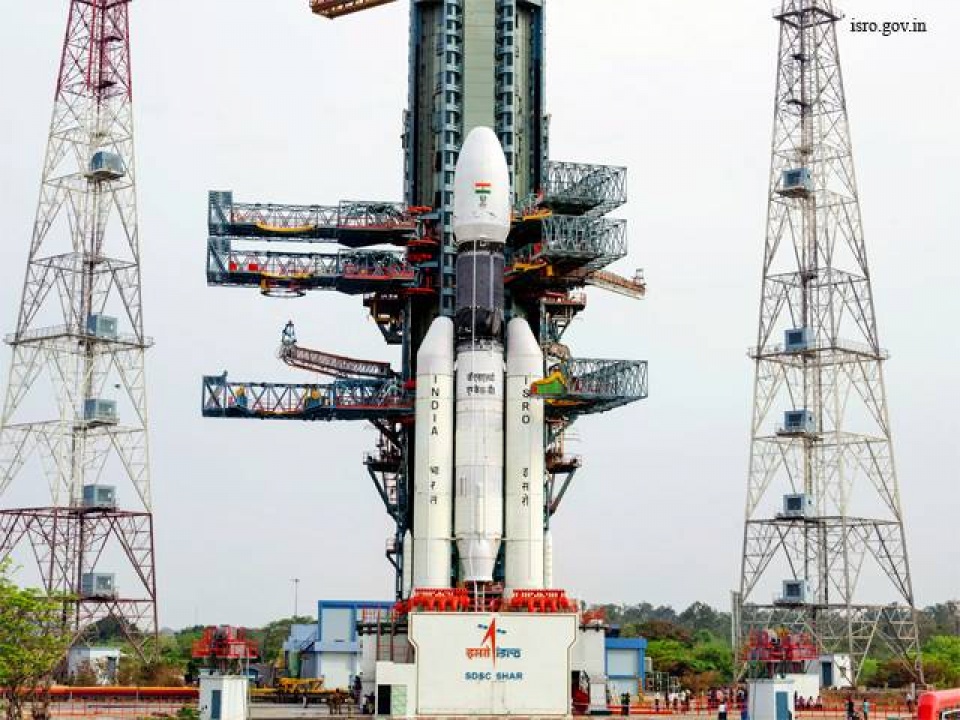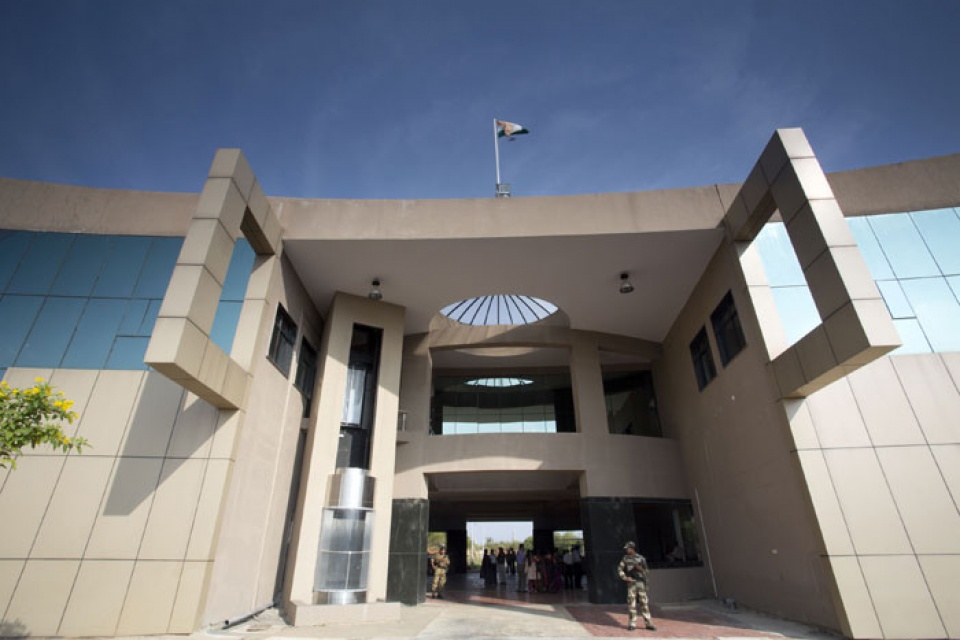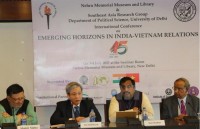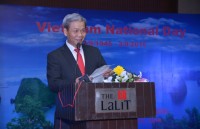
Reaching for the stars, India’s quest for the outer space: Aryabhata to Mangalyaan
Latest
| TIN LIÊN QUAN | |
| Vietnam-India trade posts strong growth | |
| Twitter Diplomacy: The Indian Success Story | |
Golden era of space technology
As India celebrates its seventieth birthday it has already entered the golden era of space technology, sectors like satellite television, banking, smart city development, weather forecasting, smart phones, e-governance, satellite aided navigation are all catering to India’s unending appetite to deploy high technology to ease the life of the common man.
India’s quest for space has been pioneered by the Indian Space Research Organisation (ISRO) set up in 1969 and today has an annual budget of about $1.4 billion. The country has a constellation of 44 satellites in orbit and can now on its own launch up to four tons of communication satellites into orbit. This gives India end to end capabilities in space technology from making its own satellites to launching its own rockets and has even sent an Indian made satellite Mangalyaan or the Mars Orbiter Mission all the way to the Mars travelling a distance of over 200 million kilometres.
 |
| Headquarters of the Indian Space Research Organization (ISRO). (Photo: Corbis/Fotosa) |
The journey for ISRO began from the humble fishing village of Thumba on the coast of the Arabian Sea where the scientists used the premises of a church to set up the first rocket launch facilities and the first rockets were carried on bicycles and first satellites pulled in on bullock carts. Today India’s heaviest rocket the Geo-synchronous Satellite Launch Vehicle Mk III (GSLV MK III) also lovingly named `Bahubaali’ weighs a whopping 640 tons or the weight of more than 200 fully grown elephants. This elegant rocket had its maiden launch on June 5, 2017 when it launched a communications satellite GSAT-19 into orbit and promises to become the mainstay for all heavy lifts.
The first satellite to be launched by India was way back in 1972 when the 360 kilogram Aryabhata satellite named after India’s legendary mathematician was lifted into orbit from the erstwhile USSR. This space science satellite paved the way for ISRO to reach for the stars. In the next few months this year India hopes to launch its heaviest ever satellite GSAT-11 that will weigh about 5725 kilograms.
By launching 'Bahubaali’ the Indian space agency entered into a bold new world muscling its way to make its mark in the world’s heavy weight multi-billion dollar launch market. ISRO chairman Dr A S Kiran Kumar a man of modest words said `we pushed ourselves to the limits to ensure that this new fully self-reliant Indian rocket succeeds in its maiden launch’.
 |
| India’s heaviest rocket the Geo-synchronous Satellite Launch Vehicle Mk III (GSLV MK III), also know as Bahubaali. |
This heavy lift rocket is capable of placing up to 8 tons in a low Earth orbit, enough to carry India’s crew module. Incidentally what may please Prime Minister on India Mr. Narendra Modi a known space buff is that this launch has `made in India boldly written all over it’.
ISRO has already prepared plans of hoisting a 2-3 member human crew into space as soon as the government gives it a sanction of about 3-4 billion dollars. The expectation is that the ISRO friendly Modi may want to leave his own stamp on history by initiating the human space flight program before the end of his first term in 2019. India would become only the fourth country after Russia, USA and China to have a human space flight program. Incidentally ISRO asserts the first Indian to go into space could well be a woman! Kumar confirms `in principle it will be the GSLV Mk-3 or its variant that will be human rated in future’.
India already has two operational rockets the workhorse Polar Satellite Launch Vehicle (PSLV) that can hoist satellites of 1.5 tons into space and was the preferred vehicle for India’s maiden mission to Moon and Mars. The second the Geosynchronous Satellite Launch Vehicle Mark II can hoist 2 ton class of satellites. Between them, ISRO has done fifty launches and recently even earned a world record by successfully placing 104 satellites in orbit beating an old Russian record of hoisting 39 satellites in a single mission.
Space diplomacy
This year India embarked on space diplomacy like never before. For the first time New Delhi flexed its prowess of space technology by embarking on an unprecedented and un-chartered `stratospheric diplomacy’ through a special Rs 450 crore gift for south Asians. India carved a very unique place in the universe, when New Delhi `gifted’ a heavy weight bird in the sky to its neighbours through the `South Asia Satellite’. India opened its heart out by extending its neighbourhood first policy beyond the stratosphere. This `gift’ of a communications satellite for use by neighbours at no cost has no parallels in the space fairing world, all other current regional consortia are commercial for-profit enterprises.
The 'South Asia Satellite' is a 2230 kilogram satellite is purely a communications satellite costing Rs 235 crores. The uniqueness of this satellite is that it has a footprint that extends all over South Asia and India gifted this heavenly messenger to its neighbours.
 |
| ISRO Mars orbiter complex. (Photo: Kemmannu.com) |
The South Asia Satellite has 12 Ku band transponders which India’s neighbours can now utilize to increase communications. Each country will get access to at least one transponder through which they could beam their own programming and there could be common `south Asian programing’ as well. Each country is developing its own ground infra-structure though India is willing to extend assistance and know-how. According to the government the satellite will `enable a full range of applications and services to our neighbours in the areas of telecommunication and broadcasting applications viz. television, direct-to-home (DTH), very small aperture terminals (VSATs), tele-education, telemedicine and disaster management support.’ The satellite also has the capability to provide secure hot lines among the participating nations in addition since the region is highly prone to earthquakes, cyclones, floods, tsunami’s it may help in providing critical communication links in times of disasters.
In this unusual message of peace, India’s most hostile neighbour Pakistan has fully opted out. Rest of the seven countries part of the South Asian Association for Regional Co-operation (SAARC) namely Afghanistan, Nepal, Bhutan, Maldives, Bangladesh and Sri Lanka are part of this mission. Experts say `Pakistan has missed an opportunity’ since its own space program is currently in a primitive stage as compared to India’s. Hopefully friendly skies can result in reduced hostilities on Earth.
In 2013 India launched the Mangalyaan the country’s first mission to Mars and it hit Bulls Eye when on September 24, 2014 it entered the orbit of Mars and India created global history by becoming the first country to reach the orbit of Mars on its maiden attempt a fact that eluded global giants like USA and Russia. Made for a nominal mission life of 180 days this year the Mangalyaan completed 1000 days in orbit and continues to beam back data and some its images like those of the full disc of Mars are so good that they featured on the cover of the venerated National Geographic magazine.
Early next year India plans to hoist its second mission to the Moon, Chandrayaa-2 which will include landing its flag on the lunar surface on an indigenous rover. Continuing with inter-planetary exploration missions are also planned for Venus and a re-visit to Mars.
Human space flight is also in the offing, India’s latest rocket the GSLV Mk III could be India’s vehicle of choice to launch `Indians into space, from Indian soil using Indian rockets’. This is only the beginning reaching for the stars and exploring the wonders of the universe are all on the horizon but whatever it does India’s common person will continue to reap the maximum benefits of India’s capabilities in space.
Pallava Bagla
| Pallava Bagla is a globally recognised Indian science journalist and author of book Reaching for the Stars: India’s Journey to Mars and Beyond’ published by Bloomsbury. He can be reached at Pallava.bagla@gmail.com |
 | Vietnam – India trade sees strong growth Vietnam – India bilateral trade increased 42.95% in the first seven months of this year, according to the Vietnam Trade Office in India. |
 | Int’l seminar celebrates Vietnam-India diplomatic ties An international conference featuring emerging horizons in Vietnam-India ties is taking place in New Delhi, attracting nearly 50 delegates from Vietnam, Singapore and India. |
 | Deputy PM Minh’s India visit to deepen bilateral partnership The upcoming visit to India by Deputy Prime Minister and Foreign Minister Pham Binh Minh aims to seek specific measures to enhance the Vietnam-India comprehensive ... |

















